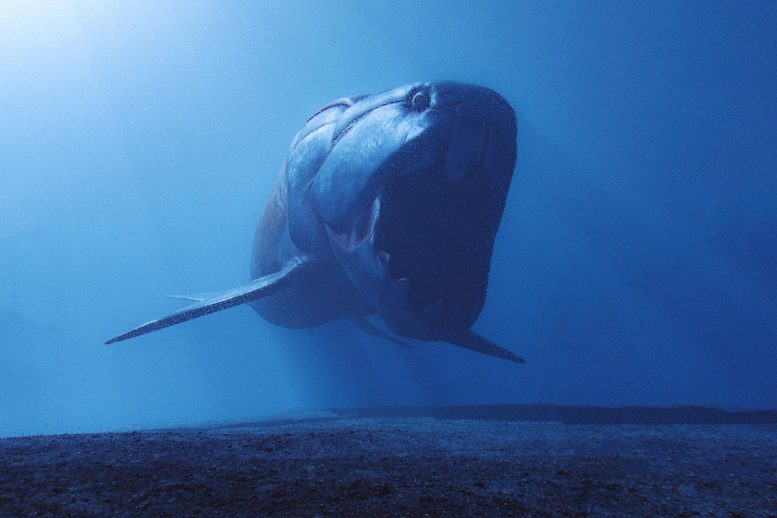
Un nuovo studio affronta il problema del dimensionamento del Dunkleosteus e di altri echinodermi artropodi del tardo Devoniano, specie ittiche estinte con scudi che coprono la testa e parte del busto. Le precedenti stime delle dimensioni si basavano sulle misurazioni della bocca e della mascella, ma questo studio ha rilevato che questi metodi non prevedevano con precisione le dimensioni del corpo negli artropodi, poiché le loro bocche erano più grandi in relazione alla lunghezza del corpo rispetto agli squali. Lo studio indica che la dimensione della bocca non può essere utilizzata per prevedere la lunghezza delle articolazioni e che la maggior parte delle lunghezze citate in precedenza per i casi di grandi artropodi sono esagerate. Una stima accurata della lunghezza del corpo e delle proporzioni degli artropodi è fondamentale per comprendere le loro abitudini di vita e l’ecologia devoniana.
In un nuovo studio, è stato scoperto che i metodi precedenti per stimare le dimensioni degli artropodi del tardo Devoniano, come Dunkleosteus, erano imprecisi. Questi pesci avevano bocche più grandi in relazione alla loro lunghezza del corpo rispetto agli squali, rendendoli capaci di attaccare prede più grandi.
Un nuovo studio del dottorando Russell Engelman della Case Western Reserve University è stato pubblicato sulla rivista La vita e l’ambiente PeerJ tenta di affrontare un problema in corso in paleontologia: qual è la dimensione di Dunkleosteus e altri artropodi tardo devoniani. I placodermi Arthrodire sono pesci estinti con scudi che coprono la testa e parte del busto, ma come gli squali, il resto del loro scheletro è fatto di cartilagine, il che significa che la maggior parte dei loro corpi non li ha preservati quando si sono fossilizzati.
Precedenti stime di volume per Dunkleosteus Dipendevano in gran parte dalla bocca e dalle mascelle di questo animale, ma questi metodi non sono mai stati testati per vedere se stimavano in modo affidabile le dimensioni della placca cutanea. Questo studio ha cercato di testare questi metodi utilizzando i dati di squali moderni e altri pesci e di verificare se prevedessero accuratamente le dimensioni del corpo negli esseri umani. Dunkleosteus e la più piccola pelle di artropodi conosciuta dai resti completi. Perché questi sono più piccoli[{” attribute=””>species are known from complete remains, they could be used to test whether previous methods accurately predicted body size in arthrodires.
“Length estimates of 5–10 m have been cited for Dunkleosteus for years,” Engelman said, “but no one seems to have checked these methods statistically or tested if they produce reliable or reasonable results in arthrodires.”

Modification of Reconstructed proportions of specimens of Dunkleosteus terrelli using the total lengths estimated by Ferron et al. (2017) using UJP. Credit: Russell Engelman (CC BY)
It turned out that mouth measurements of sharks did not accurately predict the body size of arthrodires. Complete arthrodires always had larger mouths at the same body length as sharks, and this caused mouth measurements of complete arthrodires to produce body length estimates 2–2.5 times their actual size. Dunkleosteus had an unusually large mouth even among arthrodires, further calling into question if the mouth and jaw parts of these smaller forms can be used to estimate the size of this Devonian giant.
Previously estimated lengths for Dunkleosteus also resulted in a biologically illogical body shape when applied to the known dimensions of the fossils. If previous lengths were accurate, the resulting fish would have had an extremely small, shrunken head and hyper-elongate torso even more longer than the proportions seen in most eels, at odds with a previous study published in PeerJ suggesting a shorter body more similar to pelagic sharks. The long shape implied by earlier studies would have also made the animal’s gills so small relative to its body the fish would have likely suffocated. No other arthrodires showed such extreme proportions, even though estimates based on mouth dimensions suggested they should, suggesting these prior length estimates are highly unlikely for Dunkleosteus.
Overall, this suggests mouth dimension in sharks cannot be used to predict the length of arthrodires and most previously cited lengths for large members of this group are overestimates, in agreement with the conclusions of a previous study by the same author. Arthrodires simply have much larger mouths relative to their body length than sharks, with relative mouth widths more similar to predatory catfishes.
“Dunkleosteus has often been assumed to function like a great white shark,” Engelman said, “but as we learn more about this fish it might be more accurate to describe it as a mix of shark, grouper, viperfish, tuna, and piraiba [a type of giant predatory Amazonian catfish, well known to fans of Animal Planet’s River Monsters]”
Tuttavia, per quanto possa essere deludente che questi giganteschi pesci devoniani non fossero così giganteschi come si pensava in precedenza, identificare questi animali con grandi bocche è ancora importante. In quanto predatori dell’apice devoniano, una stima accurata della lunghezza del corpo e delle proporzioni degli artropodi è fondamentale per ricostruire le loro abitudini di vita e l’ecologia devoniana in generale. In effetti, sebbene sia stato ripetutamente ricostruito sulla base degli squali, le grandi bocche di questo studio indicano che gli artropodi possono attaccare prede molto più grandi in relazione alle loro dimensioni corporee rispetto agli squali viventi. Ciò suggerisce che sebbene gli artropodi siano spesso ricostruiti sulla base di confronti con gli squali, il comportamento dei due potrebbe essere diverso da quanto si pensava in precedenza.
“La dimensione della bocca è probabilmente il fattore più importante nel determinare la preda più grande che un pesce può mangiare, e i risultati di questo studio indicano che gli artropodi stavano raggiungendo ben al di sopra della loro classe di peso”, ha detto Engelman.
Riferimento: “Bocche giganti che nuotano: le dimensioni orali degli squali esistenti non prevedono con precisione le dimensioni del loro corpo Dunkleosteus Terrelli (Placodermi: Arthrodira)” di Russell Engelman, 10 aprile 2023 Disponibile qui. Berg.
DOI: 10.7717/ peerj.15131

“Fan della TV. Risolutore di problemi malvagi. Amante del cibo appassionato. Explorer. Specialista di Internet. Imprenditore dilettante. Fanatico dell’alcol.”




